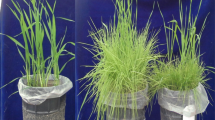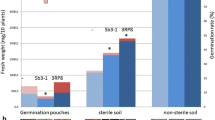Abstract
Allelopathic bacteria found to selectively inhibit weeds but not wheat in our earlier study were selected to evaluate their impact on three weeds and wheat under axenic conditions. Inoculated seeds of each species were sown in sand jars for 25 days. Results indicated that the applied strains variably inhibited germination of wild oat, little seed canary grass and broad leaved dock from 15.2 to 63.3, 18.5 to 58.7 and 18.4 to 60.5% and dry matter from 12.4 to 65, 22.8 to 81.4 and 21.7 to 71.3% than their controls, respectively. These effects were also evident in other growth parameters. Growth of wheat was significantly improved by four strains while others caused non-significant effects. Selectivity of these strains was also reflected in differential root colonization ability. These strains were characterized for various microbial and biochemical parameters. These strains may further be evaluated for their bioherbicidal activity under natural conditions.
Similar content being viewed by others
References
Abbas T (2017) Effect of allelopathic bacteria on the growth and yield of wheat (Triticum aestivum L.) and its associated weeds. PhD Dissertation. University of Agriculture, Faisalabad, Pakistan
Abd-Alla MH, Morsy FM, El-Enany AE, Ohyama T (2012) Isolation and characterization of a heavy metal resistant isolate of Rhizobium leguminosarum bv. viciae potentially applicable for biosorption of Cd+2 and Co+2. Int Biodeterior Biodegrad 67:48–55
Ashiq M, Aslam Z (2014) Weeds and weedicides. Department of Agronomy, Ayub Agricultural Research Institute, Pakistan
Ashraf M, Berge SH, Mahmood OT (2004) Inoculating wheat seedling with exopolysaccharides producing bacteria restricts sodium uptake and stimulates plant growth under salt stress. Biol Fertil Soils 40:157–162
Bender CL, Rangaswamy V, Loper J (1999) Polyketide production by plant associated pseudomonads. Annu Rev Phytopathol 37:175–196
Blair A, Ritz B, Wesseling C, Freeman LB (2015) Pesticides and human health. J Occup Environ Med 72(2):81–89
Chernin LS, Winson MK, Thompson JM, Haran S, Bycroft BW, Chet I, Williams P, Stewart GSAB (1998) Chitinolytic activity in Chromobacterium violaceum: substrate analysis and regulation by quorum sensing. J Bacteriol 180:4435–4441
Coste S, Baraloto C, Leroy C, Marcon E, Renaud A, Richardson AD, Roggy J, Schimann H, Uddling J, Herault B (2010) Assessing foliar chlorophyll contents with the SPAD-502 chlorophyll meter: a calibration test with thirteen tree species of tropical rain forest in French Guiana. Ann For Sci 67:607
Culliney TW, Nagamine WT, Teramoto KK (2003) Introductions for biological control in Hawaii 1997-2001. Proc Hawaii Entomol Soc 36:145–153
Dagno K, Lahlali R, Diourte M, Jijakli MH (2012) Present status of the development of mycoherbicides against water hyacinth: successes and challenges-a review. Biotechnol Agron Soc Environ J 16(3):360–368
Dazzo FB, Yanni YG, Rizk R, De Bruijn FJ, Rademaker J, Squartini A, Corich V, Mateos P, Martinez-Molina E, Velázquez E, Biswas JC, Hernandez RJ, Ladha JK, Hill J, Weinman J, Rolfe BG, Vega-Hernandez M, Bradford JJ, Hollingsworth RI, Ostrom P, Marshall E, Jain T, Orgambide G, Philip-Hollingsworth S, Triplett F, Malik KA, Maya-Flores J, Hartmann A, Umali-Garcia M, Izaguirre-Mayoral ML (2000) Progress in multinational collaborative studies on the beneficial association between Rhizobium leguminosarum bv. Trifoli and rice. In: Ladha JK, Reddy PM (eds) The quest for nitrogen fixation in rice. Los Banos. pp 167–189
Denslow JS, D’Antonio CM (2005) After biocontrol: assessing indirect effects of insect releases. Biol Control 35:307–318
Dobbelaere S, Vanderleyden J, Okon Y (2003) Plant growth promoting effects of diazotrophs in the rhizosphere. Crit Rev Plant Sci 22:107–149
Duncan DB (1955) Multiple range and multiple F-test. Biometrics 11:1–42
Farooq M, Bajwa AA, Cheema SA, Cheema ZA (2013) Application of allelopathy in crop production. Int J Agric Biol 15(6):1367–1378
Frederickson JK, Elliott LF (1985) Effects on winter wheat seedling growth by toxin-producing rhizobacteria. Plant Soil 83:399–409
Ghorbani R, Leifert C, Seel W (2005) Biological control of weeds with antagonistic plant pathogens. Adv Agron 86:191–225
Haas D, Keel C (2003) Regulation of antibiotic production in root colonizing Pseudomonas spp. and relevance for biological control of plant disease. Annu Rev Phytopathol 41:117–153
Hakansson S (2003) Weeds and weed management on arable land: an ecological approach. CABI Publishing, Cambridge
Hoaglands DR, Arnon DI (1950) The water-culture method for growing plants without soil. Calif Agr Expt Sta Circ 347 (Rev.)
Keel C, Schnider U, Maurhofer M, Voisard C, Laville J, Burger U, Wirthner P, Haas D, Défago G (1992) Suppression of root diseases by Pseudomonas fluorescens CHA0: importance of the bacterial secondary metabolite 2,4-diacetylphloroglucinol. Mol Plant Microbe Interact 5:4–13
Kennedy AC, Johnson BN, Stubbs TL (2001) Host range of a deleterious rhizobacterium for biological control of downy brome. Weed Sci 49:792–797
Kobayashi K (2004) Factors affecting phytotoxic activity of allelochemicals in soil. Weed Biol Manag 4(1):1–7
Kremer RJ (2006) The role of allelopathic bacteria in weed management. In: Inderjit, Mukerji KG (eds) Allelochemicals: biological control of plant pathogens and diseases. Springer, Dordrecht, pp 143–156
Kremer RJ, Souissi T (2001) Cyanide production of rhizobacteria and potential for suppression of weed seedling growth. Curr Microbiol 43:182–186
Kremer RJ, Begonia MFT, Stanley L, Lanham ET (1990) Characterization of rhizobacteria associated with weed seedlings. Appl Environ Microbiol 56:1649–1655
Kremer RJ, Caesar AJ, Souissi T (2006) Soilborne microorganisms of Euphorbia are potential biological control agents of the invasive weed leafy spurge. Appl Soil Ecol 32:27–37
Li JM, Kremer RJ (2006) Growth response of weed and crop seedlings to deleterious rhizobacteria. Biol Control 39:58–65
MacFaddin JF (1980) Biochemical tests for identification of medical bacteria. Williams and Wilkins, Baltimore
MacFaddin JF (2000) Biochemical tests for the identification of medical bacteria, 3rd edn. Lippincott Williams and Wilkins, Philadelphia
McFadyen REC (2000) Successes in biological control of weeds. In: Spencer NR (ed) Proceedings of the Xth international symposium on biological control of weeds. Advanced Litho Printing, Great Falls, MT. pp 3–14
Mehta S, Nautiyal CS (2001) An efficient method for qualitative screening of phosphate solubilizing bacteria. Curr Microbiol 43:57–58
Mejri D, Gamalero E, Tombolini R, Musso C, Massa N, Berta G, Souissi T (2010) Biological control of great brome (Bromus diandrus) in durum wheat (Triticum durum): specificity, physiological traits and impact on plant growth and root architecture of the fluorescent pseudomonad strain X33d. BioControl 55:561–572
Omer ZS, Jacobsson K, Eberhard TH, Johansson LKH (2010) Bacteria considered as biocontrol agents to control growth of white clover on golf courses. Acta Agric Scand Sect B 60:193–198
Owen A, Zdor R (2001) Effect of cyanogenic rhizobacteria on the growth of velvetleaf (Abutilon theophrasti) and corn (Zea mays L.) in autoclaved soil and the influence of supplemental glycine. Soil Biol Biochem 33:801–809
Pimentel D (2005) Environmental and economic costs of the application of pesticides primarily in the United States. Environ Dev Sustain 7:229–252
Principe A, Alvarez F, Castro MG, Zachi L, Fischer SE, Mori GB, Jofre E (2007) Biocontrol and PGPR features in native strains isolated from saline soils of Argentina. Curr Microbiol 55:314–322
Rao AN, Johnson DE, Sivaprasad B, Ladha JK, Mortimer AM (2007) Weed management in direct-seeded rice. Adv Agron 93:153–255
Rathaur P, Ramteke PW, Waseem W, John SA (2012) Isolation and characterization of nickel and cadmium tolerant plant growth promoting rhizobacteria from the rhizosphere of Withania somnifera. J Biodivers Environ Sci 6:253–261
Recep K, Fikrettin S, Erkol D, Cafer E (2009) Biological control of the potato dry rot caused by Fusarium species using PGPR strain. Biol Control 50:194–198
Robin A, Vansuyt G, Hinsinger P, Meyer JM, Briat JF, Lemanceau P (2008) Iron dynamics in the rhizosphere: consequences for plant health and nutrition. Adv Agron 99:183–225
Sarwar M, Kremer RJ (1995) Enhanced suppression of plant growth through the production of l-tryptophan-derived compounds by deleterious rhizobacteria. Plant Soil 172:261–269
Sarwar M, Arshad M, Martens DA, Frankenberger WT Jr (1992) Tryptophan dependent biosynthesis of auxins in soil. Plant Soil 147:207–215
Schwyn B, Neilands JB (1987) Universal chemical assay for the detection and determination of siderophores. Anal Biochem 160:47–56
Simons M, van der Bij AJ, Brand I, de Weger LA, Wijffelman CA, Lugtenberg BJJ (1996) Gnotobiotic system for studying rhizosphere colonization by plant growth promoting Pseudomonas bacteria. Mol Plant Microbe Interact 9:600–607
Steel KJ (1961) The oxidase reaction as a toxic tool. J Gen Microbiol 25:297–306
Steel RGD, Torrie JH, Dicky DA (1997) Principles and procedures of statistics—a biometrical approach, 3rd edn. McGraw Hill Book International Co., Singapore
Prescot LM, Harley JP, Klein DA (1993) Microbiology, 2nd edn. WCB Communications Inc, Dubuque
Yao T (2004) Associative nitrogen fixing bacteria in the rhizosphere of Avena sativa in an alpine region: III. Phosphate solubilizing power and auxin production. Acta Pratacult Sin 13:85–90
Zeller SL, Brandl H, Schmid B (2007) Host-plant selectivity of rhizobacteria in a crop/weed model system. PLoS ONE 2(9):e846. doi:10.1371/journal.pone.0000846
Acknowledgements
Authors gratefully acknowledge the financial support of Higher Education Commission, Islamabad, Pakistan (213-65052-2AV2-105) during this research work through Indigenous PhD Fellowship Program for 5000 scholars.
Author information
Authors and Affiliations
Corresponding author
Ethics declarations
Conflict of interest
Authors declare that they have no conflict of interest.
Additional information
Handling Editor: S. Raghu.
Rights and permissions
About this article
Cite this article
Abbas, T., Zahir, Z.A. & Naveed, M. Bioherbicidal activity of allelopathic bacteria against weeds associated with wheat and their effects on growth of wheat under axenic conditions. BioControl 62, 719–730 (2017). https://doi.org/10.1007/s10526-017-9836-6
Received:
Accepted:
Published:
Issue Date:
DOI: https://doi.org/10.1007/s10526-017-9836-6




